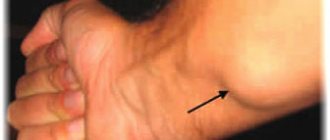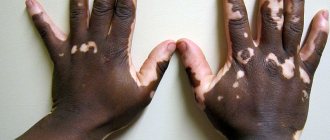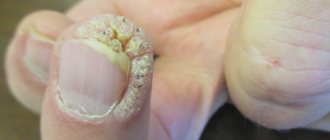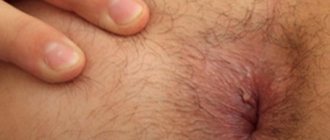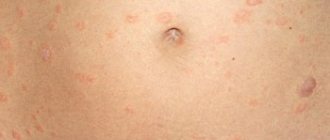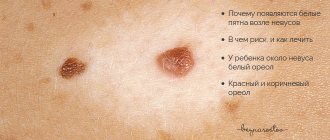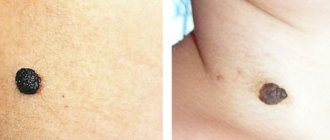For the most part, a benign formation in the form of a mole rarely bothers people. Despite this, you may come across the question “What to do if a mole itches?”
In this article we will analyze everything related to problematic nevi, and also analyze the reasons for such discomfort. Don’t forget that you need to approach your personal health with utmost care and not lose sight of even the smallest details.
Causes of itching
If your mole starts to itch, don’t panic, just watch it. After all, the occurrence of itching is not necessarily accompanied by an inflammatory process.
Most often, it appears due to mechanical impact from clothing, allergies or changes in hormone levels. These are the main reasons why a mole itches and you should pay attention to these factors before going to the doctor.
Treatment and medical intervention
When contacting a dermatologist, a person will undergo a siascopy, during which the stage of the inflammatory process is determined. After examining the patient, the dermatologist sends him to an oncologist, who prescribes tests. Histological examination can detect melanoma. Based on the histology results, appropriate treatment is prescribed. If no danger is detected, the swollen nevus will be cauterized. If a pathological process inside the formation is detected, the doctor will prescribe removal of the mole, which is carried out using the following methods:
- Laser removal is based on cauterization of the nevus using a laser. The method is safe and does not leave a scar on the body.
- Cryodestruction. Involves the use of liquid nitrogen. Used for medium and small moles.
- Radio wave removal involves the use of high-frequency current, which removes the inflamed nevus layer by layer.
- The surgical method is based on the use of a scalpel. Before the procedure, the patient is given local anesthesia. The disadvantage of the operation is the scar. Surgical intervention is necessary for large nevi.
The operation lasts half an hour. The duration of the procedure depends on the location and size of the nevus. The doctor treats the skin area with a disinfectant, administers an anesthetic, and removes the formation. After excision, it is treated with a solution that will reduce the risk of infection and sutures are applied. The removed lesion is sent for histology. The patient is advised if a mole is swollen, what it means, and how to care for the wound.
If there is no need to remove the birthmark, the doctor will prescribe medication treatment. To relieve the inflammatory process, use calendula tincture or ointment, which contains an antibiotic. Wipe the swollen area with a cotton swab dipped in tincture or ointment. Carry out the procedure until the abscess disappears. An effective remedy for removing swelling is streptocide. Crush two tablets and sprinkle on the nevus. After 15 minutes, wipe the birthmark with hydrogen peroxide.
You can relieve swelling with flax oil, which heals tissue. Pour ten drops of oil onto a cotton swab and apply to the inflamed nevus. Carry out the procedure three times a day for no more than five days. Tincture of celandine helps reduce the blister. Apply a cotton swab soaked in the solution to the mole, and stick an adhesive plaster on top. After 15 minutes, remove the lotion. Perform the procedure three to four times every day for two weeks.
An effective remedy is a mixture of garlic and lemon juice. Apply the components one at a time no more than twice a day. An ointment made from hemp oil can relieve redness, itching and thickening. To prepare you will need 15 grams of chalk and 3 pieces of butter. The treatment is carried out for 10 days three times a day. You can add fig juice to the mixture.
Surrounding area
Sometimes people notice itching not only on the mole, but also around it. A logical question immediately arises - why can it itch around a mole? We will try to answer and help you as accurately as possible.
To begin, focus your attention on the disturbing area for a couple of days. If the itching constantly intensifies, the surrounding skin begins to change its color along with the mole, and the nevus changes its shape, you should consult a doctor. He, in turn, will prescribe tests to rule out cancer and determine the nature of the itching.
The main reason for this discomfort is long exposure to the scorching sun without protective creams.
When to see a doctor
Sometimes the itching goes away on its own, and there are no obvious signs of malignancy on the mole. The following are mandatory conditions for seeing a doctor:
- convex growths of white or cloudy color appear on the mole, caused by accelerated cell division;
- severe, persistent itching and pain. The causes may be mechanical damage to the skin, growth, or the process of transformation into melanoma;
- darkening or redness of the formation, change in color of pigmented skin;
- peeling, detachment of the upper layers of the formation;
- change in volume, growth of a flat mole;
- the growth becomes dense and hurts when touched;
- accumulation of fluid or purulent contents inside the nevus;
- there is redness and inflammation of the epidermis around;
- begins to burn and tingle;
- hair loss from the birthmark;
- cracks appeared on the upper layers of the formation, blisters swelled, and ulcers formed.
The best solution would be to limit contact with the nevus. Try not to scratch or touch the mole, so as not to damage it.
It is prohibited to treat nevus at home using traditional medicine or self-prescribed drugs.
Peeling
A common cause of itching and peeling of a mole is cell division and growth of the tumor. In the second case, if pain and a change in appearance are added to this, you should definitely see a dermatologist and take the necessary tests.
In this case, you can definitely find out what is happening with the mole. In addition, exfoliation of the nevus can be a consequence of seasonal vitamin deficiency or normal dry skin.
Increase in size
Concerns often arise - what if a mole itches and grows. There are a huge number of reasons for this case, but the most common is a response to a stimulus. Also no less rare is hormonal imbalance. All this is relevant for changing sizes within small limits.
In the event of an extremely sharp and large-scale increase in the mole, you need to contact a specialist to prevent degeneration.
Redness
A change in the color of a mole and itching indicates changes in the structure of the neoplasm, which can be neutral or negative.
Your attending physician can determine malignancy and confirm the transformation; you should contact him as soon as possible. Also, malignant transformation can be supplemented by a change in shape, asymmetry of the mole and the appearance of blood.
How to diagnose?
To correctly answer the questions “why does a mole itch and what does it mean?” you will need high-quality diagnostics. After an external examination, the doctor will prescribe tests, which may include dermatoscopy, biopsy and consultation with an oncologist. In the first case, the specialist will be able to examine the tumor in more detail and determine what processes are occurring in it.
If in this case there are still doubts about the results, a biopsy is prescribed. It will accurately show the presence or absence of cancer cells.
The mole is inflamed
If a crust has formed on the nevus, this may indicate the development of an inflammatory process. Household activities often lead to this. So, if moles are located on the palms, they are most often injured. Dishwashers, cooks and hairdressers often have to deal with inflammation. Prolonged contact with water leads to dry skin and the appearance of microcracks. Moles are the first to suffer.
If a mole becomes inflamed and peeling appears, there is no need to wait for everything to go away on its own. A purulent process may begin. This will require longer and more expensive treatment. It is possible that the nevus will have to be removed. In fact, even the surgeon will not undertake removal until he is sure that it is benign. A consultation with an oncologist will be required.
A thorough diagnosis helps to find out what type of tumor you have encountered. Using a dermatoscope, a specialist examines the inflamed mole at multiple magnification. In addition, a radioisotope study may be indicated, which helps determine the presence of malignant cells in the patient's body.
If a mole peels off and a specialist suspects its malignant degeneration, a biopsy is strictly not used. The procedure can provoke tumor growth and the formation of metastases. A cytological examination of a smear of the inflamed nevus may be performed.
